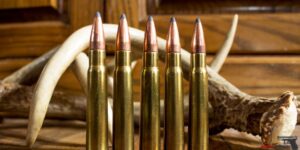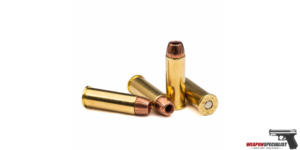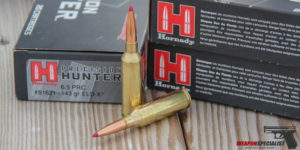When it comes to firearms and ammunition, few names evoke as much curiosity and debate as .223 and 5.56 NATO Ammo.
These popular cartridges have long been a topic of discussion among shooting enthusiasts, with each offering its unique characteristics and applications.
In this exploration, we delve into the world of .223 and 5.56 ammunition, uncovering their differences, common uses, and the factors that make them stand out in the realm of firearms.
Understanding .223 vs 5.56
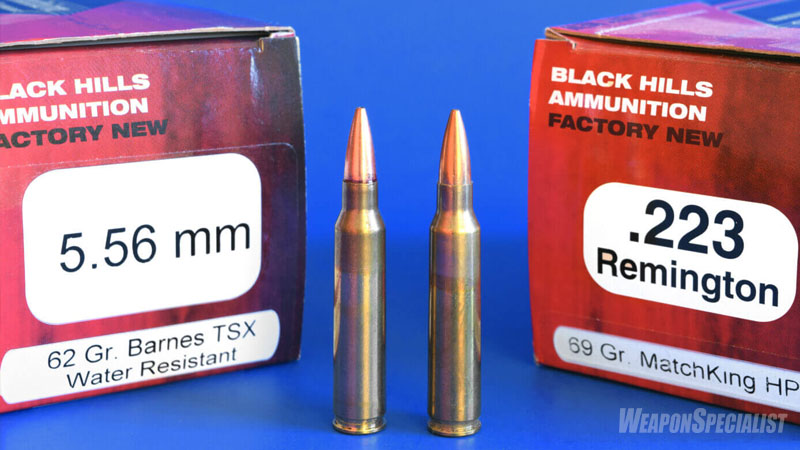
History of .223 Remington and 5.56 NATO
When it comes to understanding the difference between .223 and 5.56 NATO, it is important to first understand their history. The .223 Remington was introduced in 1964 and was designed for civilian use. It quickly gained popularity among hunters and sports shooters due to its accuracy and low recoil.
On the other hand, the 5.56 NATO was developed in the late 1950s by the US military as a replacement for the 7.62x51mm NATO cartridge. It was designed to be lighter and more efficient, while still maintaining lethality. The 5.56 NATO was officially adopted by the US military in 1963 and has been in use ever since.
Fundamental Differences
While the .223 Remington and 5.56 NATO may look similar, there are some fundamental differences between the two cartridges. The most noticeable difference is in the chamber dimensions.
The 5.56 NATO has a longer leade, which is the distance between the case mouth and the barrel rifling, than the .223 Remington. This means that while a .223 Remington cartridge can be fired in a 5.56 NATO chamber, a 5.56 NATO cartridge should not be fired in a .223 Remington chamber.
Another difference is in the pressure levels. The 5.56 NATO is loaded to a higher pressure than the .223 Remington, which allows it to achieve higher velocities and energy levels. This higher pressure also means that 5.56 NATO ammunition should not be used in firearms chambered for .223 Remington, as it can cause excessive pressure and potentially damage the firearm.
In terms of accuracy, the .223 Wylde chamber was developed as a compromise between the .223 Remington and 5.56 NATO chambers. It allows for the use of both cartridges and is known for its accuracy. However, the accuracy gain presented by using .223 Wylde is not significant enough to justify the price hike that comes with it.
Overall, it is important to understand the differences between .223 Remington and 5.56 NATO before using either cartridge. It is crucial to only use the appropriate ammunition for your firearm to ensure safety and avoid damage to your firearm.
Quick Comparison Table
| Attribute | .223 Remington | 5.56x45mm NATO |
|---|---|---|
| Bullet Diameter | 0.224 inches (5.7 mm) | 0.224 inches (5.7 mm) |
| Overall Length | 2.26 inches (57.4 mm) | 2.26 inches (57.4 mm) |
| Case Length | 1.76 inches (44.7 mm) | 1.76 inches (44.7 mm) |
| Maximum Pressure | 55,000 psi (379 MPa) | 62,366 psi (430 MPa) |
| Bullet Weight Range | 35 to 90 grains | 40 to 77 grains |
| Typical Velocity | 3,000 to 3,300 fps | 3,100 to 3,200 fps |
| Military Adoption | No | Yes |
.223 vs 5.56 Technical Specifications
5.56 Specifications
| 5.56 Specification | Value |
|---|---|
| Official NATO nomenclature | 5.56 NATO |
| Pronunciation | “five-five-six” |
| Cartridge family | Rimless bottlenecked intermediate |
| Developed by | FN Herstal |
| Cartridges in family | SS109, L110, and SS111 |
| Overall length | 2.26 inches (source: Wing Tactical) |
| Case length | 1.76 inches (source: Wing Tactical) |
| Most common bullet weights | 55 and 62 grains, with some heavier bullets maxing out at about 75 grains (source: Gunners Den) |
| Rifling twist | 178 mm or 229 mm (1 in 7 in or 9 in, originally 1 in 14 in) (source: Ammunition Store) |
| Primer type | Small rifle (source: Ammunition Store) |
| Maximum pressure | 430.00 MPa (62,366 psi) (source: Ammunition Store) |
.223 Specifications
| .223 Specification | Value |
|---|---|
| Cartridge type | Rimless, bottleneck |
| Bullet diameter | .224 in (5.7 mm) |
| Case length | 1.76 in (44.7 mm) |
| Overall length | 2.26 in (57.4 mm) |
| Rifling twist | 1 in 7 in or 1 in 9 in |
| Primer type | Small rifle |
| Maximum pressure | 55,000 psi (380 MPa) |
| Parent case | .222 Remington |
| Introduced | 1964 |
| Manufacturer | Remington Arms |
| Common bullet weights | 40 to 90 grains |
.223 vs 5.56 Pressure and Chamber
When comparing the .223 and 5.56 cartridges, the first difference that comes to mind is the pressure limit. The chamber pressure of the 5.56 NATO is higher than that of the .223 Remington. The 5.56 NATO cartridge can withstand chamber pressures of up to 62,000 psi, while the .223 Remington cartridge has a chamber pressure limit of 55,000 psi.
It is important to note that the .223 Remington cartridge can be loaded to higher pressures, up to 60,000 psi, but only in specific rifles marked as “+P.” In contrast, the 5.56 NATO is designed to operate at higher pressures, making it a more versatile cartridge.
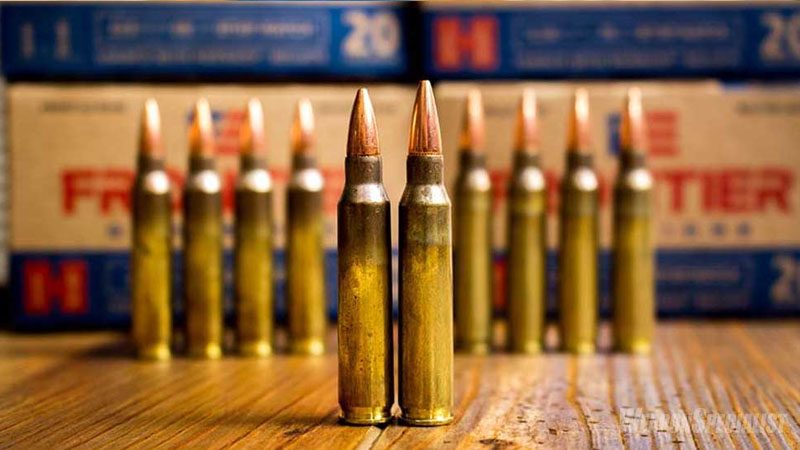
.223 vs 5.56 Cartridge and Projectile
The external dimensions of the .223 Remington and 5.56 NATO cartridges are identical. However, the 5.56 NATO cartridge has a longer leade, which is the distance between the case mouth and the barrel rifling. This longer leade allows for the use of longer, heavier bullets, which can improve accuracy and terminal ballistics.
The .223 Remington cartridge has a slightly larger case capacity than the 5.56 NATO cartridge, which can affect reloading practices. The case capacity of the 5.56 NATO is 28.5 grains H2O, while the .223 Remington has a case capacity of 28.8 grains H2O.
.223 vs 5.56 Rifling and Leade
The rifling and leade dimensions of a rifle chambered in .223 Remington and 5.56 NATO are different. The 5.56 NATO chamber has a longer leade and a shallower angle than the .223 Remington chamber. This difference in chamber dimensions affects the freebore length, which is the distance between the end of the chamber and the beginning of the rifling.
The longer leade of the 5.56 NATO chamber allows for the use of longer, heavier bullets, while the shallower angle of the rifling can improve accuracy. However, the .223 Remington chamber has a shorter leade and a steeper angle, which can improve accuracy with lighter bullets.
Overall, the technical specifications of the .223 Remington and 5.56 NATO cartridges are different in subtle but important ways. The 5.56 NATO cartridge is designed to operate at higher pressures and has a longer leade, allowing for the use of longer, heavier bullets. In contrast, the .223 Remington cartridge has a slightly larger case capacity and a shorter leade, making it better suited for lighter bullets.
.223 vs 5.56 Performance and Application
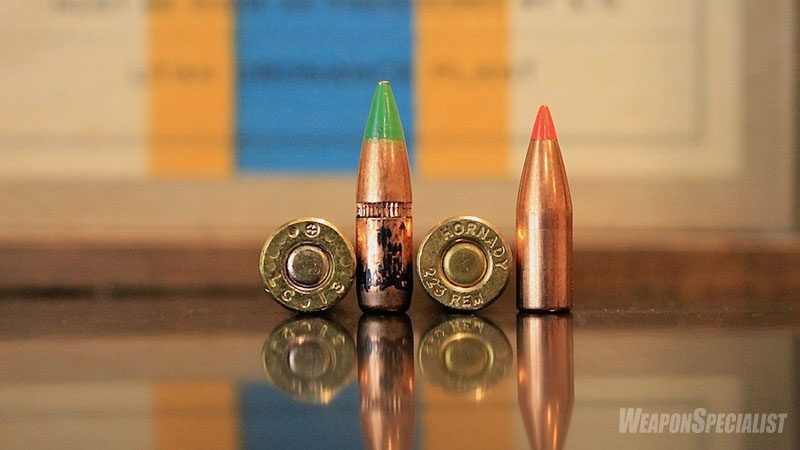
Velocity and Accuracy
When comparing the .223 and 5.56 cartridges, velocity and accuracy are two important factors to consider. The 5.56 cartridge has a higher chamber pressure than the .223, allowing for higher muzzle velocity and flatter trajectory.
This makes it a better choice for long-range shooting and hunting. However, the higher chamber pressure also means that the 5.56 cartridge generates more recoil than the .223, which can affect accuracy if not properly managed.
Reliability and Safety
Both the .223 and 5.56 cartridges are reliable and safe when used properly. However, it is important to note that the 5.56 cartridge was designed for military use and has a higher chamber pressure than the .223.
As a result, it may not be suitable for use in firearms that are not specifically designed to handle the higher pressure. It is important to always follow manufacturer guidelines and use the appropriate ammunition for your firearm to ensure reliability and safety.
Usage and Purpose
The .223 and 5.56 cartridges have different applications and purposes. The .223 is commonly used for target shooting and competition due to its accuracy and low recoil.
It is also a popular choice for self-defense due to its reliability and effectiveness at close range. The 5.56 cartridge, on the other hand, is primarily used for military and hunting purposes. Its higher muzzle velocity and flatter trajectory make it ideal for long-range shooting and hunting varmints.
Overall, both the .223 and 5.56 cartridges have their strengths and weaknesses. It is important to consider your intended use and choose the appropriate cartridge for your firearm. Always follow manufacturer guidelines and use the appropriate ammunition to ensure reliability and safety.
.223 vs 5.56 Specialized Variations
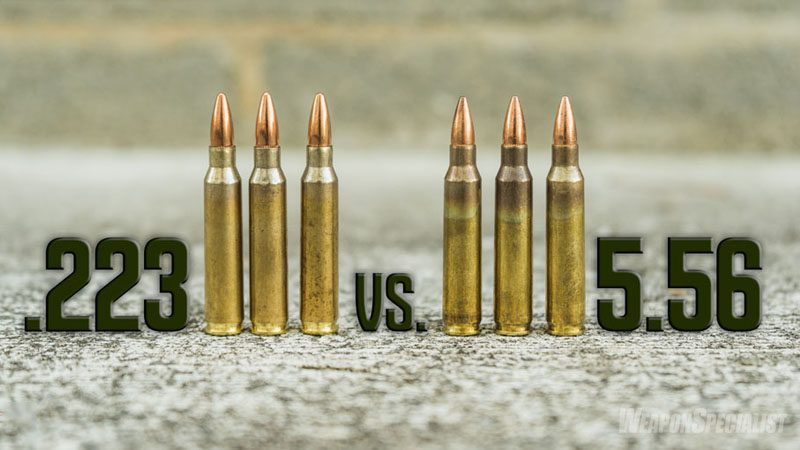
.223 Wylde
When it comes to .223 vs 5.56, there is a specialized variation of the .223 Remington chamber known as the .223 Wylde. This chamber is designed to handle both .223 Remington and 5.56x45mm NATO cartridges.
The .223 Wylde is a hybrid chamber that combines the best aspects of both chambers. It has the accuracy of the .223 Remington chamber and the reliability of the 5.56x45mm NATO chamber.
The .223 Wylde chamber has a longer throat than the .223 Remington chamber, which allows for the use of longer bullets. This, in turn, leads to better accuracy. The chamber also has a tighter neck than the 5.56x45mm NATO chamber, which helps to hold the bullet more securely.
5.56x45mm NATO
The 5.56x45mm NATO cartridge is a specialized variation of the .223 Remington cartridge. It was developed by the US military in the 1960s to replace the 7.62x51mm NATO cartridge. The 5.56x45mm NATO cartridge is designed to be fired from a military-style rifle, such as the M16 or the M4.
The 5.56x45mm NATO cartridge is loaded to a higher pressure than the .223 Remington cartridge, which gives it a higher velocity and more energy. This makes it more effective at longer ranges and against harder targets.
.300 Blackout
The .300 Blackout cartridge is a specialized variation of the .223 Remington cartridge. It was developed by Advanced Armament Corporation (AAC) in collaboration with Remington Defense. The .300 Blackout cartridge is designed to be fired from an AR-15 rifle with a modified upper receiver.
The .300 Blackout cartridge is designed to provide the same performance as the 7.62x39mm cartridge used in the AK-47 rifle. It is capable of firing both supersonic and subsonic ammunition, which makes it ideal for use with a suppressor. The .300 Blackout cartridge is also capable of firing heavier bullets than the .223 Remington cartridge, which makes it more effective at short to medium ranges.
Overall, each specialized variation of the .223 vs 5.56 has its own unique characteristics and intended uses. Understanding the differences between these variations is important when selecting the appropriate cartridge for your firearm.
Firearms and Ammunition
AR-15 and M16
The AR-15 and M16 are two popular firearms that use the .223 and 5.56mm ammunition. The AR-15 is a semi-automatic rifle that is commonly used for recreational shooting and home defense. The M16 is a military rifle that is used by the United States Armed Forces. While the two rifles look similar, there are some key differences.
The M16 has a longer barrel and a full-auto firing mode, while the AR-15 has a shorter barrel and a semi-auto firing mode. Due to the differences in barrel length, the M16 can achieve higher muzzle velocities and has a longer effective range. However, both rifles are capable of firing both .223 and 5.56mm ammunition.
Bolt-Action and AR-10
Bolt-action rifles and AR-10 rifles are two other types of firearms that can use the .223 and 5.56mm ammunition. Bolt-action rifles are typically used for hunting and long-range shooting. AR-10 rifles are similar to the AR-15, but are chambered for larger calibers such as .308 Winchester.
The .223 and 5.56mm ammunition can be used in bolt-action rifles and AR-10 rifles, but they are not as common as other calibers. The .222 Remington is a popular caliber for bolt-action rifles, while the .308 Winchester is a popular caliber for AR-10 rifles.
Ammunition Types
There are several types of ammunition available for the .223 and 5.56mm cartridges. The M855 and SS109 cartridges are commonly used by the military and have a steel core. Full metal jacket (FMJ) ammunition is also commonly used and is designed for target shooting and training.
The 5.56mm M193 cartridge is a popular choice for civilian use and is designed for varmint hunting and self-defense. The PMC X-TAC is another popular choice for civilian use and is designed for accuracy and reliability.
It is important to note that while the .223 and 5.56mm cartridges are similar, they are not interchangeable. The 5.56mm cartridge has a higher pressure and a longer leade, which can cause problems if used in a .223 chambered firearm. It is always important to use the correct ammunition for your firearm to ensure safe and reliable operation.
.223 vs 5.56 Purchase and Cost Considerations
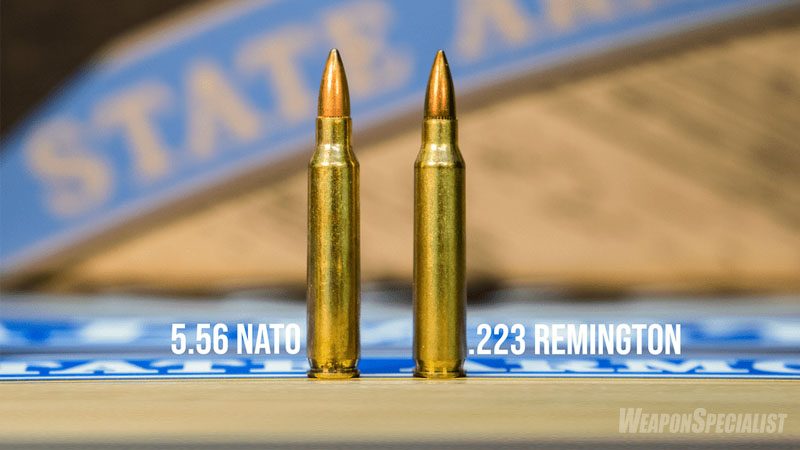
Purchasing Factors
When it comes to purchasing ammunition, there are a few factors to consider. The first is the intended use of the ammunition. If you are using it for target shooting or plinking, you may want to opt for less expensive options. However, if you are using it for self-defense or hunting, you may want to invest in higher-quality ammunition.
Another factor to consider is the manufacturer. Some manufacturers have a better reputation for producing reliable and consistent ammunition. Researching the manufacturer and reading reviews can help ensure that you are purchasing a quality product.
The case capacity of the ammunition is also important to consider. While .223 and 5.56 NATO cartridges have similar dimensions, the case capacity can vary. This can impact the velocity and pressure of the ammunition, which can affect accuracy and reliability. It is important to choose ammunition that is designed for your specific firearm.
Cost Analysis
When it comes to cost, .223 ammunition is generally less expensive than 5.56 NATO ammunition. However, it is important to consider the intended use of the ammunition. If you are using it for target shooting or plinking, the cost difference may not be significant.
However, if you are using it for self-defense or hunting, the higher-quality and more expensive 5.56 NATO ammunition may be worth the investment.
It is also important to consider the cost of reloading. Reloading can be a cost-effective option for those who shoot frequently. However, it requires an initial investment in equipment and supplies. It is important to weigh the cost savings of reloading against the upfront costs.
In summary, when purchasing ammunition, it is important to consider the intended use, manufacturer, and case capacity. The cost of the ammunition should also be taken into account, along with the potential cost savings of reloading.
Additional Information about .223 vs 5.56
Reloading
When it comes to reloading, it’s important to note that while .223 Remington and 5.56 NATO cases are typically interchangeable, there are some differences in the construction of the cases.
The 5.56 NATO case is typically thicker and has a slightly different shape to accommodate the higher pressures of the cartridge. It’s important to use the correct reloading data for each cartridge to ensure safe and reliable performance.
External Dimensions
While the external dimensions of the .223 Remington and 5.56 NATO cartridges are very similar, there are some slight differences that are worth noting.
The 5.56 NATO cartridge is typically loaded to a higher pressure than the .223 Remington, which means that the chamber dimensions of a 5.56 NATO rifle are slightly different than those of a .223 Remington rifle.
While most modern rifles are designed to handle both cartridges safely, it’s important to check with the manufacturer of your rifle to ensure that it is rated for both cartridges.
Links and Support
If you’re looking for more information on the .223 Remington and 5.56 NATO cartridges, there are plenty of resources available online. The National Rifle Association (NRA) and the Sporting Arms and Ammunition Manufacturers’ Institute (SAAMI) both provide detailed information on the cartridges, including reloading data and technical specifications.
Additionally, many manufacturers of rifles and ammunition offer technical support and customer service to help answer any questions you may have.
Products and Services
There are many manufacturers of rifles and ammunition that produce both .223 Remington and 5.56 NATO products. Some popular manufacturers include Remington, Federal, Hornady, and Winchester. Additionally, there are many companies that specialize in reloading components and equipment, such as RCBS and Dillon Precision.
Overall, it’s important to do your research and choose the right products and services for your specific needs. Whether you’re a hunter, competitive shooter, or just a recreational shooter, there are plenty of options available to help you get the most out of your rifle and ammunition.
FAQs
Which is more lethal, 5.56 or 223?
Neither 5.56 nor 223 is inherently more lethal than the other. Both cartridges can be lethal if used improperly or inappropriately. The lethality of a cartridge depends on various factors, such as bullet design, velocity, shot placement, and target anatomy. It is crucial to use proper shot placement and ethical hunting practices to ensure a quick and humane kill.
5.56 vs 223, which is better for hunting?
Both 5.56 and 223 are suitable for hunting small to medium-sized game, such as varmints, coyotes, and deer. However, 223 is generally more suitable for varmints and small game, while 5.56 is better for medium-sized game.
The main difference between 5.56 and 223 is the chamber pressure and throat dimensions. 5.56 operates at higher pressure and has a longer throat, which allows it to handle longer, heavier bullets better than 223. However, 223 is generally more accurate and produces less recoil than 5.56.
Can I shoot 223 from a 5.56 barrel?
Yes, you can safely shoot 223 from a 5.56 barrel. The chambers of both cartridges are almost identical, but the 5.56 chamber has a longer throat to accommodate longer bullets.
However, it is not recommended to shoot 5.56 from a 223 chambered firearm, as the higher pressure of 5.56 can cause excessive wear and tear on the firearm and potentially lead to catastrophic failure.
Can an AR-15 shoot 223 and 556?
Yes, most AR-15s can safely shoot both 223 and 556. However, it is important to check the barrel markings and confirm that the firearm is chambered for both cartridges before attempting to shoot them. It is also important to use the correct ammunition for the firearm and to follow proper safety procedures.
What More?
Conclusion
In conclusion, the comparison between .223 vss 5.56 ammunition has shed light on the nuanced differences that exist between these two popular rounds.
While they may seem interchangeable at first glance, their variations in chamber pressure and design make them distinct entities. Understanding these disparities is crucial for firearm enthusiasts, hunters, and military personnel alike, as it can impact accuracy, reliability, and overall performance.
To delve deeper into this topic and explore a wide range of firearm-related information, we encourage you to visit weaponspecialist.org where you will find an array of articles and resources.
By staying informed and knowledgeable, we can ensure responsible and safe handling of firearms while enhancing our appreciation for the intricacies of ballistics and ammunition.
Last Updated on November 22, 2023 by


